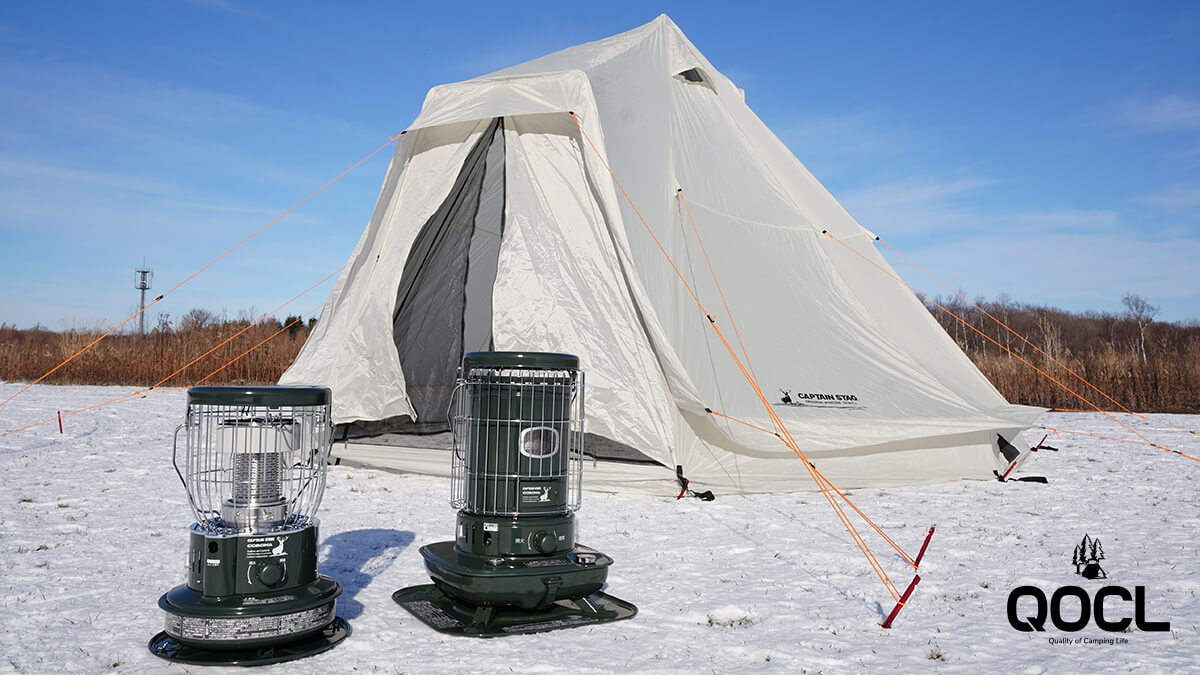
We tried out Captain Stag's "CS Classics One Pole Tent DX Octagon 460UV" plus the Corona collaboration oil stoves "SL-51CSA" and "SZ-32CS" in Hokkaido in the middle of winter!
OGZ Membership Recruitment
Of course, the winter in Hokkaido, where I live, is extremely cold. If you sleep in the tent you will definitely freeze to death.
If possible, it would be nice to use a stove even within a tent, but most tents do not use a stove. However, Captain Stag's CS Classics One Pole Tent DX Octagon 460UV and 400UV allow the company to use kerosene stoves in collaboration with the well-known heating appliance manufacturer Corona. We tested this ability in Hokkaido on Christmas.
table of contents
- What are Captain Stag's "CS Classics One Pole Tent DX Octagon 460UV" and "400UV" as well as the Corona collaboration kerosene stoves "SL-51CSA" and "SZ-32CS"?
- Detailed review
- We actually tried out how warm inside the tent can be in sub-zero Hokkaido!
- Verification with "SL-51CSA" - With an outside temperature of minus 1 degree, the tent reaches 15 degrees in about 30 minutes.
- Verification with "SZ-32CS" - The temperature inside the tent is raised from about 2.5 degrees to about 8.5 degrees...
- Summary: It's very helpful to combine it with a tent that allows you to use a kerosene stove with peace of mind.
- Details and purchase of "Captain Stag x Corona Oil Stove SL-51CSA (Dark Green)" and "Captain Stag x Corona Oil Stove SZ-32CS (Dark Green)"
What are Captain Stag's "CS Classics One Pole Tent DX Octagon 460UV" and "400UV" as well as the Corona collaboration kerosene stoves "SL-51CSA" and "SZ-32CS"?
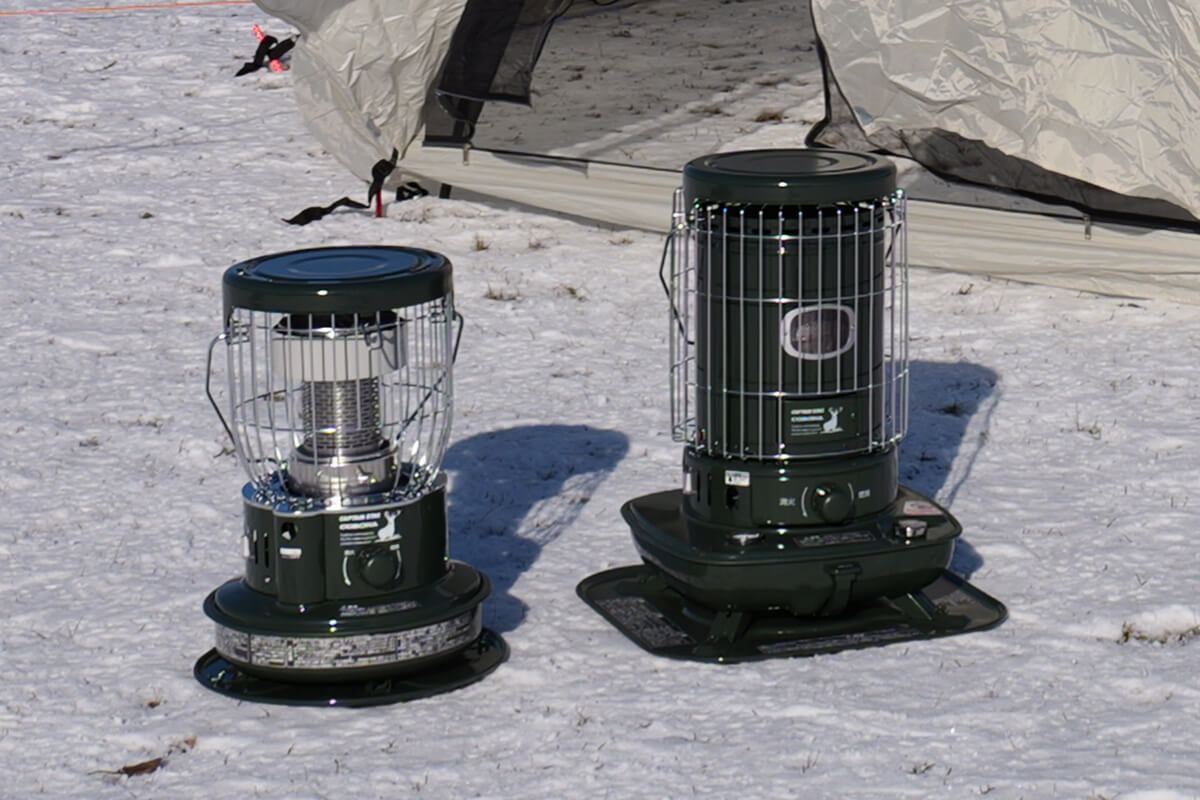
The left side of the photo is "Captain Stag x Corona Oil Stove SZ-32CS (Dark Green)" and the right side is "Captain Stag x Corona Oil Stove SL-51CSA (Dark Green).".
Using a stove in a tent is a very dangerous thing
First of all, I would like to say that using a stove inside a tent is a very dangerous thing. There is a risk of carbon monoxide poisoning and fire, so using a stove inside a tent in conditions that are not safe no matter how cold it is, can be life-threatening.
Basically, the manuals for tents that are commonly sold in Japan should clearly state that fire is prohibited. Of course, there are almost no tents in the tent that say you can use a stove. However, Captain Stag's CS Classics One Pole Tent DX Octagon 460UV and CS Classics One Pole Tent DX Octagon 400UV (hereinafter referred to as 400UV), are clearly stated that it can be used with the company's collaboration model with the popular heating appliance manufacturer Corona, Captain Stag x Corona Oil Stove SL-51CSA (Dark Green) and Captain Stag x Corona Oil Stove SZ-32CS (Dark Green) (hereinafter referred to as SZ-32CS).
This is one of the few combinations of kerosene stoves and tents that can be used by the manufacturer. This time, we tested the heating effect by combining it with the "CS Classics One Pole Tent DX Octagon 460UV" (hereinafter referred to as 460UV). In addition, we have introduced the details of "460UV" in our previous article "Can you avoid dangerous heat? Captain Stag's spacious and comfortable tent "CS Classics One Pole Tent DX Octagon 460UV" and a spot cooler where we tried out how comfortable summer camping is [QOCL Improvement Committee #003]" , so this article will focus on the oil stoves "SL-51CSA" and "SZ-32CS". The actual price of the SL-51CSA is around 34,800 yen, while the SZ-32CS is around 35,800 yen.
Recommended points
- Captain Stag x Corona exclusive color, dark green color (both models)
- One pole tent can be used with 460 UV and 400 UV (both models)
- Burning duration of approximately 12 hours, allowing for long continuous use (both models)
- Heating output 5.14kW (SL-51CSA) that can be heated up to a living room class of about 15 tatami mats
- Heating output 3.19kW (SZ-32CS) that can be heated up to 10 tatami mats and bedrooms.
- Oil stoves (both models) that are easy to obtain fuel and easy to prepare and clean up
- Easy to ignite with a battery-powered ignition switch (SL-51CSA)
Points that interest me
- You will need to remove the floor seat and open the lower vent (both models)
- There is no ignition device, so an ignition lighter is required (SZ-32CS)
Main Specifications and ratings
| item | Captain Stag x Corona Oil Stove SL-51CSA (Dark Green) | Captain Stag x Corona Oil Stove SZ-32CS (Dark Green) |
|---|---|---|
| External dimensions | Height 553mm, width 460mm, depth 460mm (including stand) | Height 475mm, width 355mm, depth 355mm (including stand) |
| mass | Approximately 9.9kg | Approximately 6.3kg |
| Oil tank capacity | Approximately 6.0L | Approximately 3.8L |
| Model | SL-51CSA (basic model SL-5123) | SZ-32CS (basic model SZ-32) |
| kinds | Shin-style/natural convection | Shin-style/natural convection |
| Ignition method | Battery ignition Single type/2 units | Ignition lighter |
| Fuel used | Kerosene (JIS No. 1 Kerosene) | Kerosene (JIS No. 1 Kerosene) |
| Fuel consumption | 5.14kW (0.500L/h) | 3.19kW (0.310L/h) |
| Heating output | 5.14kW | 3.19kW |
| Burning duration | Approximately 12.0 hours | Approximately 12.3 hours |
| Heating | Wooden construction up to 21.5㎡ (13 tatami mats) and concrete up to 29.5㎡ (18 tatami mats) | Wooden construction up to 15.0㎡ (9 tatami mats) and concrete up to 20.0㎡ (12 tatami mats) |
| Shin/Type | Normal tube, nominal dimensions: inner diameter 105mm, thickness 3.5mm | Normal tube, nominal dimensions: inner diameter 75mm, thickness 2.8mm |
| Safety Device | Automatic fire extinguishing device | Automatic fire extinguishing device |
| Outdoor Gearzine Rating | ||
| Heating output | ★★★★☆ | ★★★☆☆ |
| design | ★★★☆☆ | ★★★★☆ |
| Burning time | ★★★★☆ | ★★★★☆ |
| Ease of use | ★★★★☆ | ★★★☆☆ |
| Cost Performance | ★★★★☆ | ★★★☆☆ |
Detailed review
We actually tried out how warm inside the tent can be in sub-zero Hokkaido!

The SL-51CSA and SZ-32CS were tested at Forever Camping Paradise, located right next to New Chitose Airport.
Both the SL-51CSA and SZ-32CS are collaboration models between Corona, a well-known heating manufacturer, and Captain Stag, with the SL-51CSA being the base model, "SL-5123", and the SZ-32CS being the base model. Both are kerosene stoves that are well-known for COVID-19, and both are made from JIS No. 1 kerosene, which is commonly sold as kerosene at gas stations and fuel stores, so it's nice that fuel is easy to obtain and cost-effective. The dark green coloring used on both models is very suitable for outdoor scenes such as camping, but it is a limited edition color only for the Captain Stag and Corona collaboration model. Both stoves are made from natural convection to raise the heated air and create convection, causing the entire room to warm.
The major differences between the two collaborative kerosene stoves are their size, weight, heating output, and ignition method. The SL-51CSA is 553mm tall, 460mm wide, 460mm deep (including stand), weighs approximately 9.9kg and heating output of 5.14kW, while the SZ-32CS is 475mm tall, 355mm wide, and 355mm deep (including stand), weighs approximately 6.3kg and heating output of 3.19kW. Regarding the ignition method, the SL-51CSA uses two AA batteries sold separately, but the SZ-32CS requires a commercially available ignition lighter, which you will need to prepare separately. When it comes to ignition, the "SL-51CSA" is the advantage in terms of convenience, and the "SZ-32CS" is the advantage in terms of its atmosphere. Personally, I prefer the SZ-32CS design.
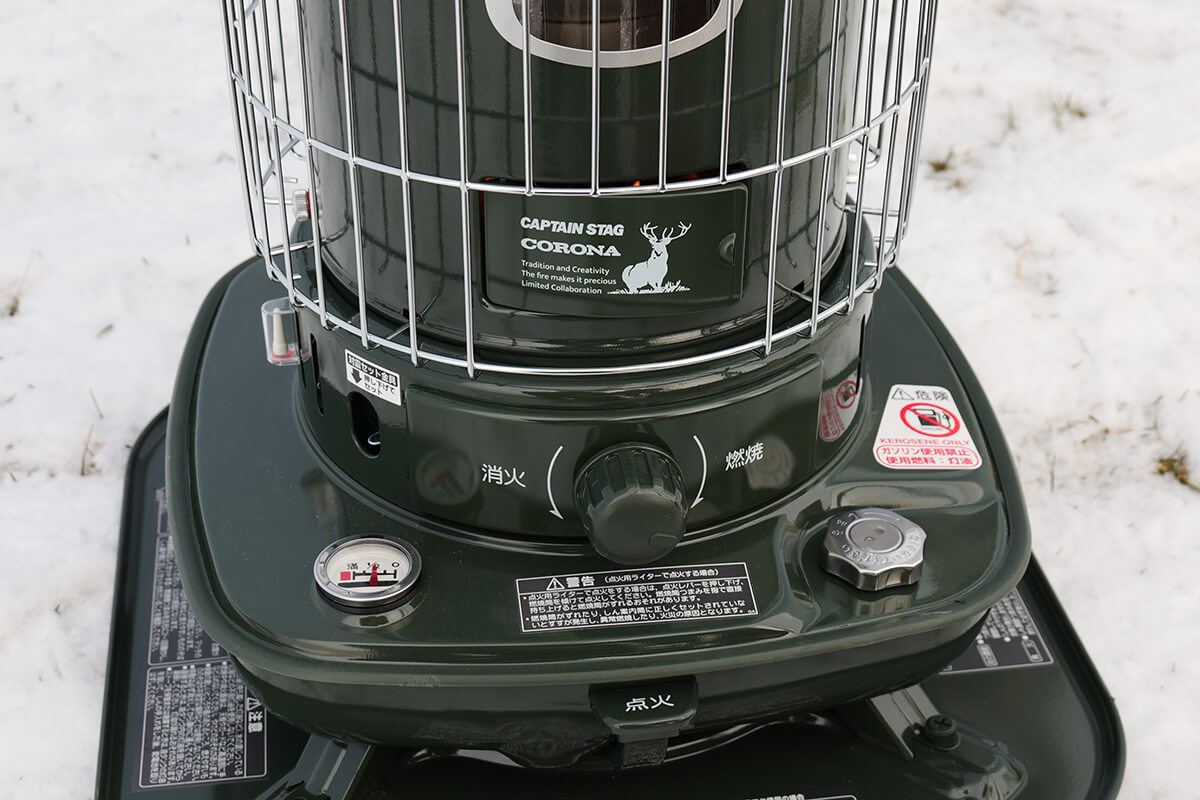
The "SL-51CSA" has a switch with the words "ignition" written on it at the bottom of the main unit, and press this to light it.
Regarding the fuel tank, the SL-51CSA is 6.0L and the SZ-32CS is 3.8L, but the combustion duration for both is approximately 12 hours. Both models continue to burn for about half a day after refueling, so there is no need to add kerosene frequently. This is a collaboration model with a long-established heating manufacturer, so both are extremely stable and easy to use kerosene stoves.
Before this test, the most important point is to carefully check the "Captain Stag limited edition tents (UA-47 and UA-46) and the instruction manual (Notes) for use within a tent that can be used" included with the SL-51CSA and SZ-32CS. "UA-47" = "CS Classics One-Pole Tent DX Octagon 460UV" and "UA-46" = "CS Classics One-Pole Tent DX Octagon 400UV" contains detailed instructions on how to handle and precautions when using "SL-51CSA" or "SZ-32CS", so be sure to read carefully. There are four major points: not using floor seats, not installing an inner tent, opening two vents in the top and bottom of the tent, and installing a stove on a level surface, with a distance of more than 100 cm from the tent.
Verification with "SL-51CSA" - With an outside temperature of minus 1 degree, the tent reaches 15 degrees in about 30 minutes.
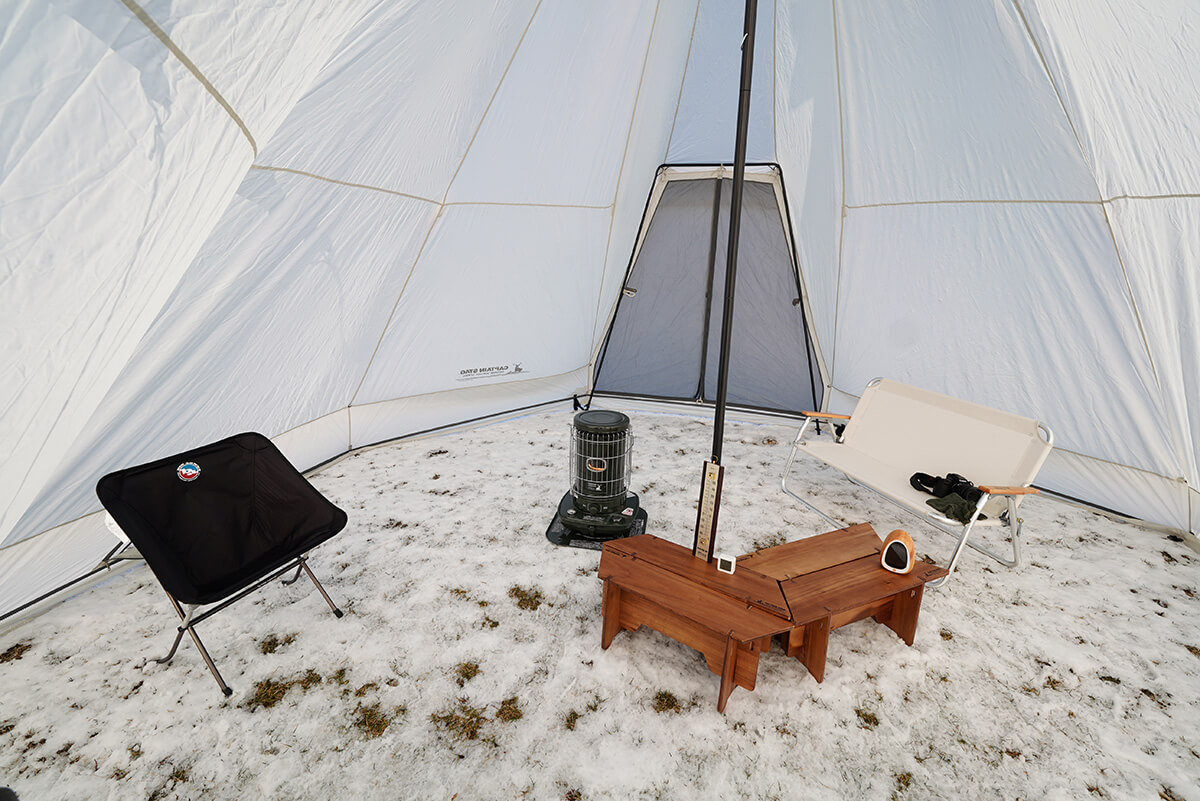
The "SL-51CSA" is placed in the center of the "460UV". You will see that the inside of the "460UV" is quite spacious.
Following the precautions, we placed the SL-51CSA inside the 460UV to light it, and measured the temperature inside the tent every 15 minutes. At this time, the temperature outside the tent was about -1.2 degrees. Although it was during the day, the results of the test were below freezing temperatures.
■Temperature changes in the tent "460UV" x "SL-51CSA"
| Time (min) | Temperature (℃) |
|---|---|
| 0 | Approximately 9.5 |
| 15 | Approximately 11.5 |
| 30 | Approximately 15.0 |
| 45 | Approximately 15.0 |
| 60 | Approximately 15.0 |
| 75 | Approximately 15.5 |
The temperature outside the tent is below freezing, but the weather was good, so the sunlight was strong, and the inside of the tent is about 9.5 degrees, which is much better than outdoors. We installed the SL-51CSA here to set the fire, but the temperature inside the tent steadily rose, reaching 11.5 degrees in 15 minutes and approximately 15.0 degrees in 30 minutes. However, for ventilation, the ventilation holes (ventilation) with each of the top and bottom of the 460UV are fully open, so perhaps the warmth that is lost and the newly generated warmth balances, and although the temperature inside the tent was about 15.0 degrees after 45 minutes and 60 minutes, it was about 15.5 degrees after 75 minutes, but it is probably within the range of error.
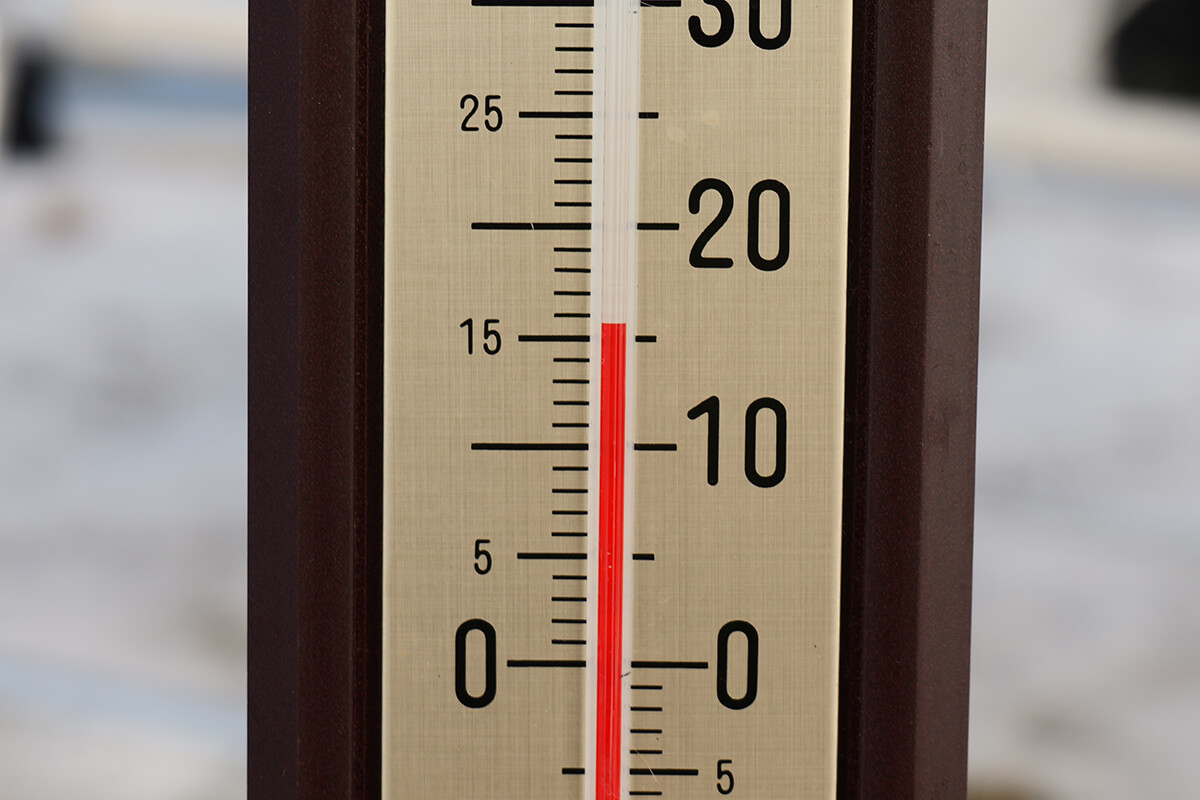
The 460UV warmed with the SL-51CSA was the best, and as shown in the photo, it was warmed to 15.5 degrees, or even nearly 16 degrees. It's about minus 1 degree outside, so it feels very warm.
However, compared to the sub-zero world outside the tent, the 460UV heated with the SL-51CSA is extremely comfortable. 15 degrees is a bit cold indoors, so you can enjoy the comfort of your own, as it is a light outdoor wear. I was in the tent for an experiment, but it was so comfortable that I didn't want to go outside. I also had a friend take part in the experiment, but when I sit in a 460UV heated with the SL-51CSA, I hate moving. The SL-51CSA is designed to be cooked on top of this, so if you boil water and cook warm drinks or meals, you'll be even happier.
Verification with "SZ-32CS" - The temperature inside the tent is raised from about 2.5 degrees to about 8.5 degrees...
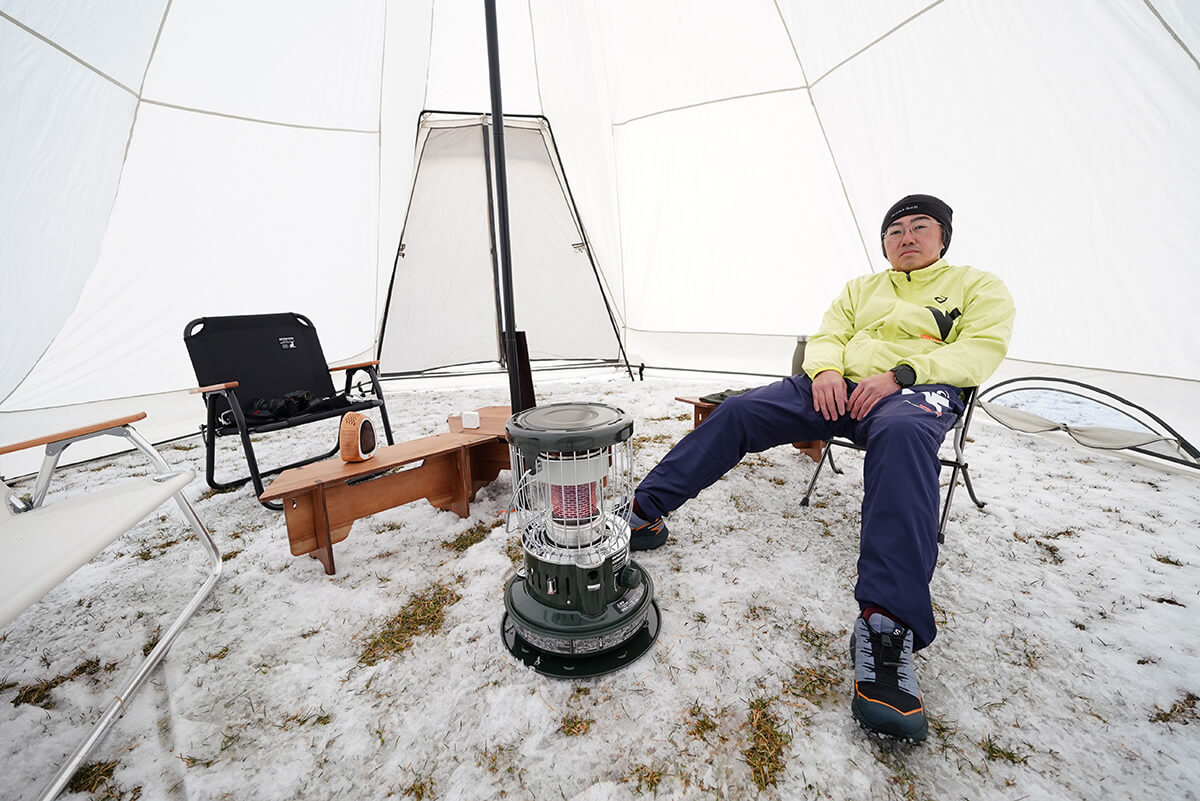
The "SZ-32CS" is placed in the center of the "460UV". It is slightly smaller than the SL-51CSA, so it can be easily handled inside the tent.
I thought it would be quite difficult to warm inside a 460UV with the SZ-32CS, which has only 3.19kW of heating output, compared to the 5.14kW of the SL-51CSA, and only 60% output. After the SL-51CSA test was completed, I tested the SZ-32CS, and the start time was approximately 3pm, and since the warm air was replaced in the previous test, the temperature inside the tent at the start was about 2.5 degrees. Furthermore, please take into consideration that the temperature was falling towards the sunset, scheduled for 4:04 pm, but the test results for the "SZ-32CS" are as follows.
■Temperature changes in the tent "460UV" x "SL-51CSA"
| Time (min) | Temperature (℃) |
|---|---|
| 0 | Approximately 2.5 |
| 15 | Approximately 6.5 |
| 30 | Approximately 8.5 |
| 45 | Approximately 6.0 |
| 60 | Approximately 5.0 |
| 75 | Approximately 5.0 |
The temperature inside the tent also rose steadily for about 30 minutes from the start, but after 45 minutes the temperature began to drop even though the stove was on. The outside temperature, which was minus 1°C when the test began, actually dropped to minus 3°C around 4:04pm, which was the time of sunset, and as shown in the photo below, it became a nice dusk, and it was not even helped by the sun.

The temperature inside the tent has risen to about 8.5 degrees and nearly 9 degrees. After this, the outside temperature dropped and the sun set neared, so the temperature inside the tent also dropped.
Also, if you were to use the SZ-32CS, I felt that the tent would be better suited to the 400UV, which is smaller than the 400×400×250cm tall, rather than the 460UV. If you place importance on heating output, you'll probably end up with the "SL-51CSA."
Incidentally, although this combination is safe, since an oil stove is used inside the tent, a carbon monoxide detector was placed, but the air inside the tent was maintained at a level that did not give a minimum of 0.02% warning, which means that you will experience a mild frontal headache in 2-3 hours. The effect of fully opening the two vents on the top and bottom is also reflected in this area.
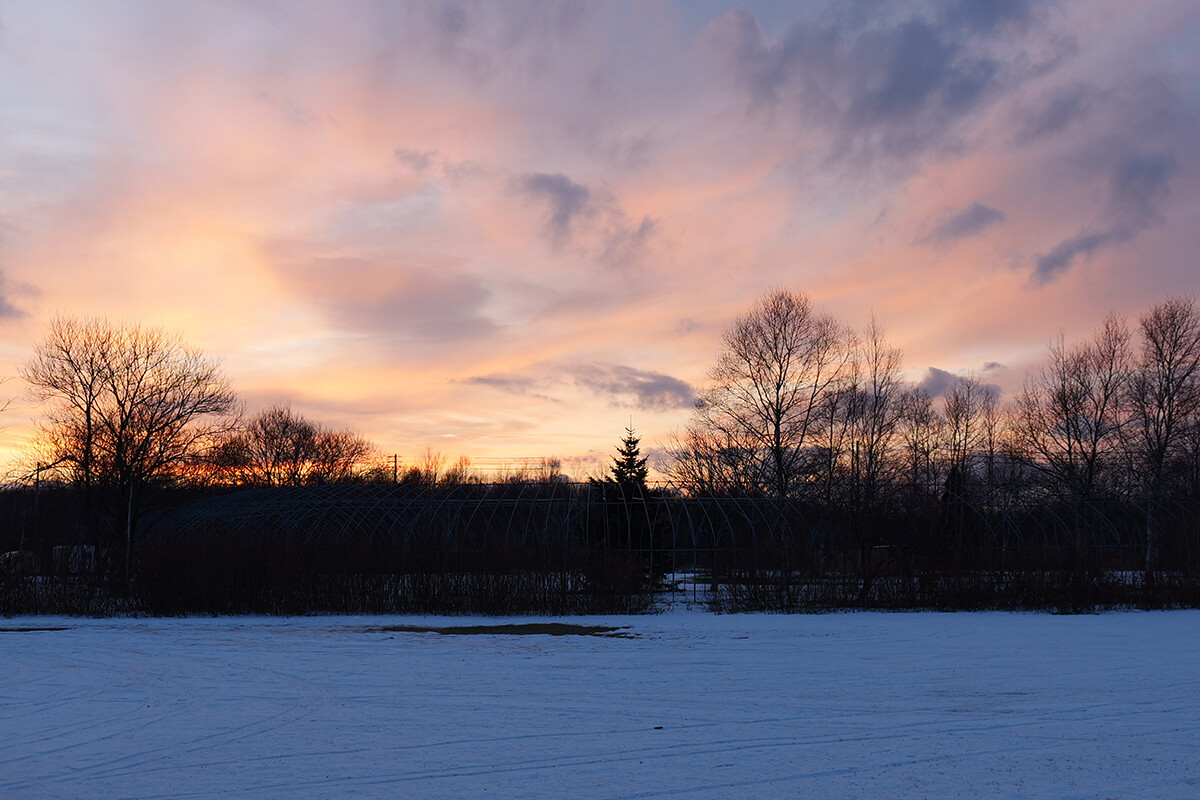
The view outside the second half of the test looks like this. The temperature also fell to -3 degrees, which was a disadvantage for the SZ-32CS.
Summary: It's very helpful to combine it with a tent that allows you to use a kerosene stove with peace of mind.
I was impressed that even when the ventilation was fully open, it would be more warm than expected.
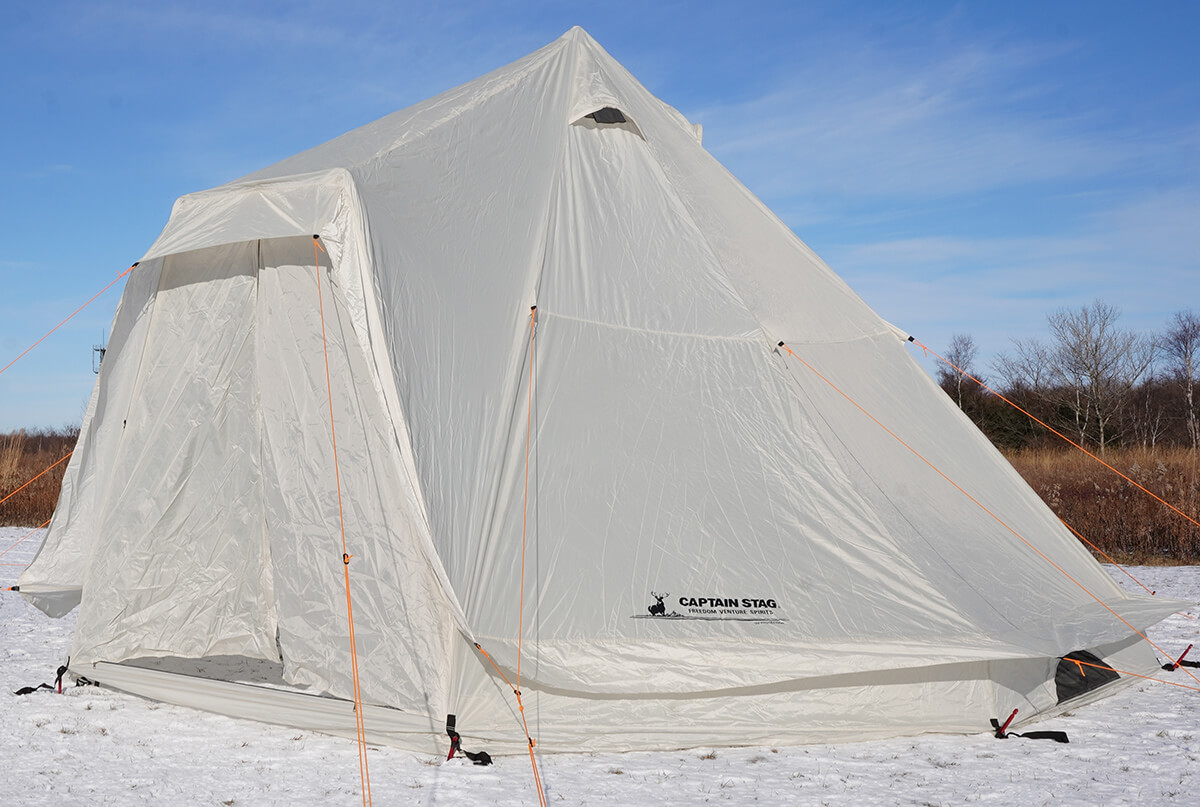
Can you see that there are quite large vents at the vertex of the "460UV" and at the bottom right of the screen? This is also on the other side, and a total of four vents need to be opened.
To put it simply, for me, the results of heating tests for the 460UV, SL-51CSA, and SZ-32CS were better than I expected. Before actually using it, I knew that I had to fully open the ventilation, each with two ventilations on the top and bottom of the tent, so how much warmer can I keep in Hokkaido below freezing? Actually, I was quite worried.
The tests for the 460UV and SL-51CSA also included solar support, but the temperature inside the tent rose to around 15 degrees Celsius when the temperature was around minus 1 degree Celsius. If you think about it at room temperature, the temperature below zero and 15 degrees Celsius will be completely different, not only in terms of winter wear, but also in the sleeping bags used. However, you will have to extinguish the fire when you go to sleep, so you may have to consider rotating the fire. Also, although we used a larger "460UV" this time, if combined with a smaller "400UV", the temperature inside the tent will rise even further.
The test using the combination of the SZ-32CS and 460UV was quite harsh in Hokkaido in the evening at 3 degrees below zero, but the temperature inside the tent was still around 5.0 degrees, so the difference with the outside temperature was 8 degrees. It will be effective if the outside temperature is cold, not below freezing. I also felt that the SZ-32CS would be more practical when combined with a slightly smaller "400UV."
Oil stoves are very convenient because they don't have to prepare or clean up the food like a wood stove, and burn time is not short like a cassette gas stove, and they don't need to frequently refill or replace fuel even if you think of it for an overnight period. What's more, it gives you even greater peace of mind when it can be used in a tent with the manufacturer's approval. In winter, just a fire inside the tent makes you feel warmer than the actual temperature difference. Set up a tent in the snow, and enjoying the warmth of the heating, spending time relaxing with friends and family is incredibly rich. If you're worried about using a stove inside your tent, why not consider purchasing it in combination with Captain Stag's tents, "460UV" or "400UV" or "kgfm" stoves, or "SL-51CSA" or "SZ-32CS". For me, who lives in Hokkaido, I felt that the warmer 400UV and SL-51CSA were the best.
Details and purchase of "Captain Stag x Corona Oil Stove SL-51CSA (Dark Green)" and "Captain Stag x Corona Oil Stove SZ-32CS (Dark Green)"
For more information about the product, please visit the Captain Stag official website
Photography cooperation
Right next to New Chitose Airport! " Forever Camping Paradise "
Saito Titoce
 Former monthly camera magazine editor. While pursuing the spectacular views of Hokkaido and the wildlife, I was completely hooked on the outdoor life of camper vans and sleeping in my car. While traveling the entire country with his 2-year-old son and wife, he is a photographer writer who photographs and writes everything he has experienced, not only cameras and lenses, but also outdoor camping, child-rearing, PC gadgets, cooking, and dieting. OUTDOOR GEARZINE plans to write a variety of articles, focusing on the QOCL (Quality of Camping Life) Improvement Committee, which will improve the quality of life in camping and camper vans.
Former monthly camera magazine editor. While pursuing the spectacular views of Hokkaido and the wildlife, I was completely hooked on the outdoor life of camper vans and sleeping in my car. While traveling the entire country with his 2-year-old son and wife, he is a photographer writer who photographs and writes everything he has experienced, not only cameras and lenses, but also outdoor camping, child-rearing, PC gadgets, cooking, and dieting. OUTDOOR GEARZINE plans to write a variety of articles, focusing on the QOCL (Quality of Camping Life) Improvement Committee, which will improve the quality of life in camping and camper vans.





 [Can you avoid dangerous heat?] 】Captain Stag's spacious and comfortable tent "CS Classics One Pole Tent DX Octagon 460UV" and a spot cooler, we tried out how comfortable summer camping is [QOCL Improvement Committee #003]
[Can you avoid dangerous heat?] 】Captain Stag's spacious and comfortable tent "CS Classics One Pole Tent DX Octagon 460UV" and a spot cooler, we tried out how comfortable summer camping is [QOCL Improvement Committee #003]